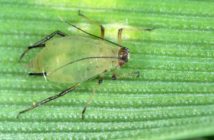A biostimulant that boosts yield by increasing root biomass could present a valuable option to help stressed crops recover from one of the wettest winters in decades, says Agrii’s northern technical manager Jim Carswell.
Trials by Agrii with stabilised amine nitrogen (SAN) – like many biostimulants, technically a fertiliser – showed yield increases of up to 0.55t/ha in winter wheat.
“Strip trials in Inverness in the 2022/23 season examined the effect of SAN when used on top of a standard nutrition programme, determined by leaf analysis,” he explains.
“In the treated plots, where SAN was applied at T0/T1, the average yield increase of more than 0.5 t/ha was mainly attributed to the SAN’s effect on ear numbers at this site. They rose from an average of 585/m2 in the control, to 666/m2 where the SAN product was applied.”
Mr Carswell notes that amine nitrogen has a very specific effect on the crop, unlike more commonly used forms of nitrogen such as nitrate or urea. “Its main effect is to stimulate production of the plant hormone cytokinin.
“Cytokinins’ effect on root growth is well-documented in previous amine studies, and it’s this which increases the number of shoots and tillers, and hence ear numbers.”
Trials on the same farm in 2023 also examined the effect of SAN on spring barley.
“We had the opportunity to assess what effects SAN might have on a late-drilled crop,” he says. “After the crop was drilled on 6 April, applications of 1.5l/ha made at T1/T2 delivered a yield increase over the control of 0.32t/ha.”
Based on these results, he has already deployed SAN – as Levity Crop Science’s Lono – in this season’s crops to examine another claimed SAN feature.
“The science around how the plant absorbs amine nitrogen is very interesting,” he points out. “Previous studies have shown that it can help the plant ‘draw in’ certain nutrients that it wouldn’t otherwise so readily absorb.
The trial at Agrii’s Bishop Burton site in Yorkshire saw Lono applied to winter barley at 2l/ha, on November 17, alongside 2.5l/ha of manganese sulphate. Examination of plant roots 27 days later revealed an increase in root length of 6.5% over the control, while NDVI analysis showed increased biomass and green cover across the treated plots.
“By February 12, 87 days after application, tissue analysis showed Mn levels to be 45% higher in Lono-treated plants.
“We won’t know whether these metrics have any effect on yield until later in the year, but given the previous year’s results, we expect that longer, more robust rooting and increased tiller numbers will again deliver an observable yield increase,” he predicts.
“This season’s winter crops need all the help they can get, and Lono’s ability to enhance rooting certainly makes it a prime candidate for consideration,” he says.
“Good roots are going to be very important for spring crops, too,” he suggests. “Who knows when the ground is going to be good for travel? For many crops, that will mean late drilling and a shortened growing season. But crops that can get a head start on establishing a strong root system will be ahead of the curve.
“Bear in mind, too, that rainfall tends to average out in most years. I would not be surprised to see a dry period later in the year; investing in roots now will stand crops in good stead for what might lie ahead,” he advises.
“We’ll continue to run trials with Lono through this year, but what we’ve seen so far suggests it’s doing everything we expect of it, which is exciting. It’s one of those rare biostimulants that comes with a lot of science behind it.”




